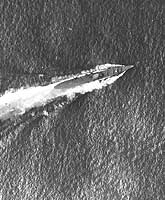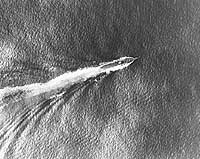
Chikuma, a 11215-ton Tone class heavy cruiser built at Nagasaki, Japan, was commissioned in May 1939. After several months as a unit of the Sixth Squadron (Sentai 6) of the Second Fleet, she was transferred to the Sentai 8 in November 1939. In addition to taking part in regular combat exercises in Japanese home waters, she operated off southern China on three occasions between March 1940 and March 1941.
Chikuma's design provided a large seaplane capacity, fitting her for long-range scouting missions, and she was extensively employed during the Second World War as a consort for aircraft carriers. She accompanied the powerful task force that delivered the 7 December 1941 Attack on Pearl Harbor, and one of her planes flew a pre-strike reconnaissance mission over the target area. On the way back to Japan, she supported the capture of Wake Island. In the first four months of 1942, Chikuma was part of the carrier force during assaults in the Southern Pacific, the East Indies and the Indian Ocean. On 1 March, her guns helped sink the U.S. destroyer Edsall (DD-219) south of Java. She again was with the Japanese carriers when they were decisively defeated in the Battle of Midway on 4 June 1942.
During August-October 1942, Chikuma operated with the carriers during the Guadalcanal Campaign, taking part in the Battle of the Eastern Solomons on 24 August and the Battle of the Santa Cruz Islands on 26 October. She was moderately damaged by American dive bomber attacks in the latter action and was under repair in Japan until late February 1943. She mainly served in the central Pacific area during the year, but was sent south to Rabaul early in November 1943 to counter the U.S. landings on Bougainville, and was lightly damaged by U.S. carrier planes on the 5th of that month.
Chikuma was transferred to Sentai 7 in early 1944. She participated in a cruiser raid on Indian Ocean shipping in March and in mid-June again accompanied aircraft carriers during the Battle of the Philippine Sea, an action that effectively destroyed Japan's seaborne air power. Four months later, in response to the invasion of Leyte, Chikuma steamed to the Philippines to attack Allied forces there. She survived attacks by submarines and aircraft on 23-24 October. On the following day, in the Battle off Samar, she engaged U.S. escort carriers, helping to sink USS Gambier Bay (CVE-73), but was soon hit by an aerial torpedo attack and immobilized. Her crew was taken off by the destroyer Nowaki and Chikuma was scuttled in the late morning of 25 October 1944. While withdrawing from the battle area, Nowaki was herself sunk, with the loss of all but one of Chikuma's surviving crewmen.
This page features all the images we have concerning the Japanese heavy cruiser Chikuma.
| If you want higher resolution reproductions than the digital images presented here, see: "How to Obtain Photographic Reproductions." |
Click on the small photograph to prompt a larger view of the same image.
|
Photo #: 80-G-30614 Battle of the Santa Cruz Islands, October 1942 Japanese heavy cruiser Chikuma underway during the battle, as seen from a USS Enterprise (CV-6) aircraft, 26 October 1942. Note smoke coming from her bridge area, which had been hit by a bomb. Official U.S. Navy Photograph, now in the collections of the National Archives. Online Image: 183KB; 740 x 615 pixels Reproductions of this image may also be available through the National Archives photographic reproduction system. Note: see Photo # NH 82404 for a version of this photograph that has been cropped to better emphasize the ship. |
 |
|
Photo #: NH 82404 Chikuma (Japanese Heavy Cruiser, 1939) Under air attack during the Battle of the Santa Cruz Islands, 26 October 1942. Photographed from a USS Enterprise (CV-6) plane. Note the smoke coming from her bridge area, which had been hit by a bomb, and what appears to be a recognition marking painted atop her number two eight-inch gun turret. The ship's catapults and aircraft crane appear to be swung out over her sides, aft of amidships. The original photograph came from Rear Admiral Samuel Eliot Morison's World War II history project working files. U.S. Naval History and Heritage Command Photograph. Online Image: 149KB; 610 x 765 pixels Note: see Photo # 80-G-30614 for the entire image from which this view has been cropped. |
 |
|
Photo #: 80-G-89107 Chikuma (Japanese Heavy Cruiser, 1939) Photographed from a USS Saratoga (CV-3) SBD scout bomber's gun camera, during the raid on Rabaul, 5 November 1943. Official U.S. Navy Photograph, now in the collections of the National Archives. Online Image: 125KB; 740 x 605 pixels Reproductions of this image may also be available through the National Archives photographic reproduction system. |
 |
|
Photo #: 80-G-287537 Chikuma (Japanese Heavy Cruiser, 1939) Photographed from a U.S. Navy carrier plane during the Battle off Samar, 25 October 1944. Her stern has been hit by a torpedo and cut off short, though the ship's outboard propellers are still able to keep her underway. Official U.S. Navy Photograph, now in the collections of the National Archives. Online Image: 130KB; 740 x 620 pixels Reproductions of this image may also be available through the National Archives photographic reproduction system. |
 |
NOTES:
| If you want higher resolution reproductions than the digital images presented here, see: "How to Obtain Photographic Reproductions." |
Page made 17 January 2002
Coding updated 6 May 2009